Consider two different bullets of the same weight as different bullets when working up load data. Sometimes, results will be very similar as to velocity, point of impact, apparent pressure, etc. with similar or the same powder charge, but often they are not. I've always found having access to lots of paper published data an invaluable resource.
Install the app
How to install the app on iOS
Follow along with the video below to see how to install our site as a web app on your home screen.
Note: This feature may not be available in some browsers.
You are using an out of date browser. It may not display this or other websites correctly.
You should upgrade or use an alternative browser.
You should upgrade or use an alternative browser.
Is there much difference to load using different but same grain bullets
- Thread starter Davey Boy
- Start date
-
- Tags
- same grain
Bearing surface may or may not have a significant effect on pressure; hardness of the jacket material may also have an effect. That's why you treat bullets of the same weight but different design by different manufacturers as different bullets, at least until you've done enough load development and shooting to indicate they are are similar.
Last edited:
Yes I agree. As I mentioned I have 3 load manuals, a couple of online manuals, QL and GRTools as well as my labradar, and I keep records of everything. Can't have enough info in my mind. I understand what each of you have said, and yes just the time in searching for a better accuracy in itself is a rewarding hobby in itself. Guess even though I don't have as much time as I'd like, I should just enjoy the pursuit and not worry as much about the outcome (accuracy). As usual I enjoy all the replies so thanks to all.Consider two different bullets of the same weight as different bullets when working up load data. Sometimes, results will be very similar as to velocity, point of impact, apparent pressure, etc. with similar or the same powder charge, but often they are not. I've always found having access to lots of paper published data an invaluable resource.
I do it often for mild to moderate loads in applications where the highest accuracy is not desired. The first shots are always on the paper and accuracy stays within a factor of two.
But for more precision match loads - F-Class, Benchrest, long range - changing bullets requires repeating careful load work up. Hotter loads also require repeating careful load work up when changing bullets.
But for more precision match loads - F-Class, Benchrest, long range - changing bullets requires repeating careful load work up. Hotter loads also require repeating careful load work up when changing bullets.
dellet
Gold $$ Contributor
One of the best things you can do when switching bullets in any data, is to verify all measurements for yourself. Seating depth will vary based on bullet length and nose profile may or may not hit the lands. Both can cause pressure spikes. Even what would seem reliable manufacturers data has mistakes.
This point was driven home some years ago when 300 Blackout came out. Every bullet manufacturer in the world makes a 145-150 grain FMJ bullet for the military. They are not created equal. Using Hornady published data at the time and Sierra, Hornady, Winchester, and PPU FMJ bullets, one of the four would jam the lands at the published length. It was the Hornady bullet, using Hornady data.
Clearly a very rare occurrence, but the idea of “trust but verify” was clearly driven home.
JBM has many bullet lengths listed, Quick load can calculate seated depth. Nothing except actual measurement can verify when the bullet hits the lands.
This point was driven home some years ago when 300 Blackout came out. Every bullet manufacturer in the world makes a 145-150 grain FMJ bullet for the military. They are not created equal. Using Hornady published data at the time and Sierra, Hornady, Winchester, and PPU FMJ bullets, one of the four would jam the lands at the published length. It was the Hornady bullet, using Hornady data.
Clearly a very rare occurrence, but the idea of “trust but verify” was clearly driven home.
JBM has many bullet lengths listed, Quick load can calculate seated depth. Nothing except actual measurement can verify when the bullet hits the lands.
After an experience developing a good 50gr load for a 222 that had any boattail tried grouping 0.75 MOA yet plain old Hornady #2240 SX grouped 0.25 MOA all day long it depends much on each rifle.
50 gr BT's were the worst 222 group yet group the best in my Model 7 223.
Go figure.......still confused.
50 gr BT's were the worst 222 group yet group the best in my Model 7 223.
Go figure.......still confused.
Speer has long grouped bullets of same diameter and construction but different profiles in their load data. Here's an example in 30-06 Springfield from the Speer Reloading Manual #14 - SPRN alongside spitzer boat tail all cup & core together with others.
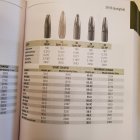
However the same diameter and weight Trophy Bonded Bear Claw has specific seperate data due to differences in construction.
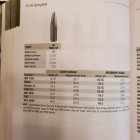
Similar with handun with even TMJ sharing data with cup & core
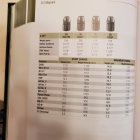
But non-jacketed lead bullets having different data with barrel leading potential in mind
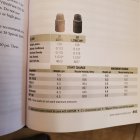
And where applicable separate short barrel data for velocities from a shorter barrel length than the other load data was generated with
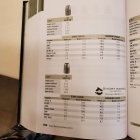

However the same diameter and weight Trophy Bonded Bear Claw has specific seperate data due to differences in construction.

Similar with handun with even TMJ sharing data with cup & core

But non-jacketed lead bullets having different data with barrel leading potential in mind

And where applicable separate short barrel data for velocities from a shorter barrel length than the other load data was generated with

Many boattail bullets shoot very accurately. However, if I have a choice between flat base and boattail in the initial phase of working up a load, I'll start with the flat base bullet. There's a good chance it will be at least slightly more accurate than the boattail. And, if you're shooting at distances under 400-500 yards, the higher ballistic coefficient of the boattail may not mean much anyway.After an experience developing a good 50gr load for a 222 that had any boattail tried grouping 0.75 MOA yet plain old Hornady #2240 SX grouped 0.25 MOA all day long it depends much on each rifle.
50 gr BT's were the worst 222 group yet group the best in my Model 7 223.
Go figure.......still confused.
CharlieNC
Gold $$ Contributor
Several years ago I did ladder testing across a very wide charge range using 155, 168, and 175 gr bullets in a 308. The node, based on stable vertical poi, was the same for all and was at an OBT for all. Due to less pressure it was possible to take the 155 up to the next OBT for higher velocity. Much can be read into this observation.
It is an interesting question....It is an interesting question. I haven't done a lot of this, but back in 1994, I loaded up a bunch of .308's with 168 grain SMK's, and then for giggles, I loaded up some Speer 168 HPBT's using the same powder charge and seating depth.
It is anecdotal and coincidental, but I got near exact same performance from both loads. At 100 Yards, both loads would put all shots into one hole as long as I didn't shoot the group too fast. I could cover both groups with a nickel.
The rifle was an early Remington PSS with an HS stock. When I would fire fast and hot, the groups would disperse laterally, which I found curious. A close friend, who had instructed at Range 37 told me that the original M24's showed the same lateral dispersion tendency when fired hot.
IMO surface area can affect pressure. So if you run a load at max and then switch to a different but same weight bullet but that bullet has more contact surface area you can get over pressure. But GENERALLY speaking I cross reference similar bullets often with min. to no issues other than accuracy of course.
I loaded some 168 gr. Amaxs with the same load as 168 gr. Match that I had (both very similar bullets) and the Amax shot 36 fps on average faster and grouped 1/2 min to left.
Interesting about everyone's take on this. And it's confirming what I thought about 2 different bullets with the same grains. I never load at the max unless I work from the lower loads up, but since most of my loads are in the mid range I figure that I could go from one good known load to another bullet of the same weight with just a little testing. I would never try that if I was near maximum pressure loads. Another reason why I love QL and GRTools to verify my thinking. As well as numerous manuals and online manuals.
Similar threads
- Replies
- 9
- Views
- 1,192
Upgrades & Donations
This Forum's expenses are primarily paid by member contributions. You can upgrade your Forum membership in seconds. Gold and Silver members get unlimited FREE classifieds for one year. Gold members can upload custom avatars.

Click Upgrade Membership Button ABOVE to get Gold or Silver Status.
You can also donate any amount, large or small, with the button below. Include your Forum Name in the PayPal Notes field.
To DONATE by CHECK, or make a recurring donation, CLICK HERE to learn how.

Click Upgrade Membership Button ABOVE to get Gold or Silver Status.
You can also donate any amount, large or small, with the button below. Include your Forum Name in the PayPal Notes field.
To DONATE by CHECK, or make a recurring donation, CLICK HERE to learn how.









